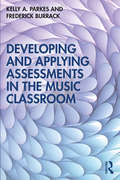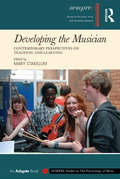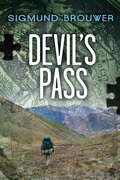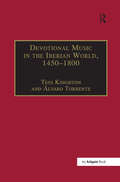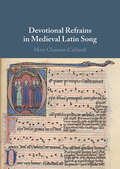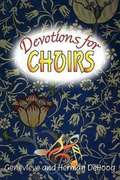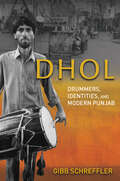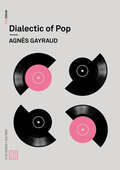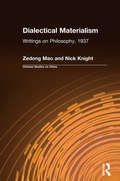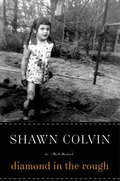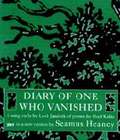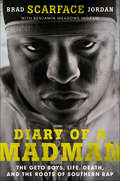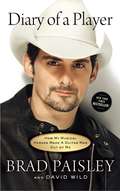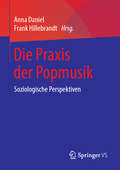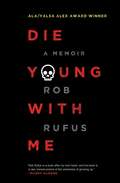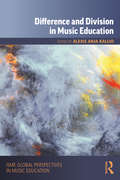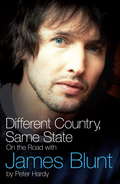- Table View
- List View
Developing and Applying Assessments in the Music Classroom
by Kelly A. Parkes Frederick BurrackDeveloping and Applying Assessments in the Music Classroom addresses the challenges faced by today’s K-12 educators and future music educators who are expected to utilize and incorporate assessment data as a hallmark of student learning and reflection of effective teaching. Highlighting best practices while presenting current scholarship and literature, this practical workbook-style text provides future music teachers with a framework for integrating assessment processes in the face of a certain lack of understanding and possible dissatisfaction with assessment tools and tasks. Each chapter is prefaced by an overview outlining learning expectations and essential questions, and supplemented throughout by an array of pedagogical features: Discussion prompts Activities and worksheets Learning experiences Expanded reference lists Citing examples across a range of musical settings—e.g. band, chorus, orchestra, jazz, and piano and guitar labs—Developing and Applying Assessments in the Music Classroom builds from the classroom assessment paradigm, encouraging teachers to create assessment tasks most appropriate to their curricula goals and planned student outcomes. Joined by fellow experts in the field Brian C. Wesolowski and Phillip Payne, the authors invite readers to explore and apply the material in authentic ways to inspire student learning through a comprehensive approach to educative assessment.
Developing the Musician: Contemporary Perspectives on Teaching and Learning (SEMPRE Studies in The Psychology of Music)
by Mary StakelumTo what extent does research on musical development impact on educational practices in school and the community? Do musicians from classical and popular traditions develop their identities in different ways? What do teachers and learners take into consideration when assessing progress? This book takes a fresh look at 'the musician' and what constitutes 'development' within the fields of music psychology and music education. In doing so, it explores the relationship between formative experiences and the development of the musician in a range of music education settings. It includes the perspectives of classroom teachers, popular musicians, classical musicians and music educators in higher education. Drawn from an international community of experienced educators and researchers, the contributors offer a range of approaches to research. From life history through classroom observation to content analysis, each section offers competing and complementary perspectives on contemporary practice. The book is an essential resource for musicians, educators, researchers and policy makers, offering insight into the reality of practice from those working within established traditions - such as the conservatoire and school settings - and from those who are currently emerging as significant forces in the fields of popular music education and community music.
Deviant Opera: Sex, Power, and Perversion on Stage
by Axel EnglundImagine Armida, Handel’s Saracen sorceress, performing her breakneck coloraturas in a black figure-hugging rubber dress, beating her insubordinate furies into submission with a cane, suspending a captive Rinaldo in chains from the ceiling of her dungeon. Mozart’s peasant girl Zerlina, meanwhile, is tying up and blindfolding her fiancé to seduce him out of his jealousy of Don Giovanni. And how about Wagner’s wizard, Klingsor, ensnaring his choir of flower maidens in elaborate Japanese rope bondage? Opera, it would appear, has developed a taste for sadomasochism. For decades now, radical stage directors have repeatedly dressed canonical operas—from Handel and Mozart to Wagner and Puccini, and beyond—in whips, chains, leather, and other regalia of SM and fetishism. Deviant Opera seeks to understand this phenomenon, approaching the contemporary visual code of perversion as a lens through which opera focuses and scrutinizes its own configurations of sex, gender, power, and violence. The emerging image is that of an art form that habitually plays with an eroticization of cruelty and humiliation, inviting its devotees to take sensual pleasure in the suffering of others. Ultimately, Deviant Opera argues that this species of opera fantasizes about breaking the boundaries of its own role-playing, and pushing its erotic power exchanges from the enacted to the actual.
Devil's Pass (Seven (the Series))
by Sigmund BrouwerSeventeen-year-old Webb's abusive stepfather has made it impossible for him to live at home, so Webb survives on the streets of Toronto by busking with his guitar and working as a dishwasher. When Webb's grandfather dies, his will stipulates that his grandsons fulfill specific requests. Webb's task takes him to the Canol Trail in Canada's Far North, where he finds out that there are much scarier things than the cold and the occasional grizzly bear. With a Native guide, two German tourists and his guitar for company, Webb is forced to confront terrible events in his grandfather's past and somehow deal with the pain and confusion of his own life.
Devotional Music in the Iberian World, 1450-1800: The Villancico and Related Genres
by TESS KNIGHTON AND ÁLVARO TORRENTEFrom the fifteenth century to the beginning of the nineteenth century, devotional music played a fundamental role in the Iberian world. Songs in the vernacular, usually referred to by the generic name of 'villancico', but including forms as varied as madrigals, ensaladas, tonos, cantatas or even oratorios, were regularly performed at many religious feasts in major churches, royal and private chapels, convents and in monasteries. These compositions appear to have progressively fulfilled or supplemented the role occupied by the Latin motet in other countries and, as they were often composed anew for each celebration, the surviving sources vastly outnumber those of Latin compositions; they can be counted in tens of thousands. The close relationship with secular genres, both musical, literary and performative, turned these compositions into a major vehicle for dissemination of vernacular styles throughout the Iberian world. This model of musical production was also cultivated in Portugal and rapidly exported to the Spanish and Portuguese colonies in America and Asia. In many cases, the villancico repertory represents the oldest surviving source of music produced in these regions, thus affording it a primary role in the construction of national identities. The sixteen essays in this volume explore the development of devotional music in the Iberian world in this period, providing the first broad-based survey of this important genre.
Devotional Refrains in Medieval Latin Song
by Mary Channen CaldwellThroughout medieval Europe, male and female religious communities attached to churches, abbeys, and schools participated in devotional music making outside of the chanted liturgy. Newly collating over 400 songs from primary sources, this book reveals the role of Latin refrains and refrain songs in the musical lives of religious communities by employing novel interdisciplinary and analytical approaches to the study of medieval song. Through interpretive frameworks focused on time and temporality, performance, memory, inscription, and language, each chapter offers an original perspective on how refrains were created, transmitted, and performed. Arguing for the Latin refrain's significance as a marker of form and meaning, this book identifies it as a tool that communities used to negotiate their lived experiences of liturgical and calendrical time; to confirm their communal identity and belonging to song communities; and to navigate relationships between Latin and vernacular song and dance that emerge within their multilingual contexts.
Devotions for Choirs
by Genevieve DehoogThese brief, easy-to-use devotions are ideal for use during choir rehearsal or before a choir program. Each devotion includes Scripture, devotional reflection, and a prayer.
Dewey and Elvis: The Life and Times of a Rock 'n' Roll Deejay
by Louis CantorBeginning in 1949, while Elvis Presley and Sun Records were still virtually unknown--and two full years before Alan Freed famously "discovered" rock 'n' roll--Dewey Phillips brought rock 'n' roll to the Memphis airwaves by playing Howlin' Wolf, B. B. King, and Muddy Waters on his nightly radio show Red, Hot and Blue. The mid-South's most popular white deejay, "Daddy-O-Dewey" is part of rock 'n' roll history for being the first major disc jockey to play Elvis Presley (and subsequently to conduct the first live, on-air interview with Elvis). This book illustrates Phillips's role in turning a huge white audience on to previously forbidden race music. His zeal for rhythm and blues legitimized the sound and set the stage for both Elvis's subsequent success and the rock 'n' roll revolution of the 1950s. Using personal interviews, documentary sources, and the oral history collections at the Center for Southern Folklore and the University of Memphis, Louis Cantor presents a very personal view of the disc jockey while arguing for his place as an essential part of rock 'n' roll history.
Dhol: Drummers, Identities, and Modern Punjab
by Gibb SchrefflerAn icon of global Punjabi culture, the dhol drum inspires an unbridled love for the instrument far beyond its application to regional vernacular music. Yet the identities of dhol players within their local communities and the broadly conceived Punjabi nation remain obscure. Gibb Schreffler draws on two decades of research to investigate dhol's place among the cultural formations within Punjabi communities. Analyzing the identities of musicians, Schreffler illuminates concepts of musical performance, looks at how these concepts help create or articulate Punjabi social structure, and explores identity construction at the intersections of ethnicity, class, and nationality in Punjab and the diaspora. As he shows, understanding the identities of dhol players is an ethical necessity that acknowledges their place in Punjabi cultural history and helps to repair their representation. An engaging and rich ethnography, Dhol reveals a beloved instrumental form and the musical and social practices of its overlooked performers.
Dialectic of Pop (Urbanomic: Mono #8)
by Agnes GayraudA philosophical exploration of pop music that reveals a rich, self-reflexive art form with unsuspected depths. In the first major philosophical treatise on the subject, Agnès Gayraud explores all the paradoxes of pop—its inauthentic authenticity, its mass production of emotion and personal resonance, its repetitive novelty, its precision engineering of seduction—and calls for pop (in its broadest sense, encompassing all genres of popular recorded music) to be recognized as a modern, technologically mediated art form to rank alongside cinema and photography. In a thoroughgoing engagement with Adorno's fierce critique of "standardized light popular music," Dialectic of Pop tracks the transformations of the pop form and its audience over the course of the twentieth century, from Hillbilly to Beyoncé, from Lead Belly to Drake. Inseparable from the materiality of its technical media, indifferent and intractable to the perspectives of high culture, pop subverts notions of authenticity and inauthenticity, original and copy, aura and commodity, medium and message. Gayraud demonstrates that, far from being the artless and trivial mass-produced pabulum denigrated by Adorno, pop is a rich, self-reflexive artform that recognises its own contradictions, incorporates its own productive negativity, and often flourishes by thinking "against itself."Dialectic of Pop sings the praises of pop as a constitutively impure form resulting from the encounter between industrial production and the human predilection for song, and diagnoses the prospects for twenty-first century pop as it continues to adapt to ever-changing technological mediations.
Dialectical Materialism: Writings on Philosophy, 1937
by Nick Knight Zedong MaoNew and annotated translations of philosophical essays written by Mao Zedong in 1937, which have come to be regarded as a cornerstone in the development of Chinese Marxism. The editor analyzes their textual, philosophical and historical significance.
Diamond in the Rough: A Memoir
by Shawn ColvinThe three-time Grammy–winning singer-songwriter chronicles her life and successes, as well as her struggles with depression, anxiety, and alcoholism.After learning to play guitar at the age of ten, Shawn Colvin was determined to make a life in music—a decision that would send a small-town girl out on the open road for good. In 1997, two decades after she started, she got her big break. Like the troubled would-be arsonist and survivor of her smash hit “Sunny Came Home,” Colvin knows a thing or two about heartache—and setting fires. Diamond in the Rough recounts this passionate musician’s coming-of-age, from the prairies of South Dakota to the dark smoky bars in Austin, Texas, to the world stage at the Grammys.Humorous and deeply honest, Colvin relates the experiences behind her best-loved songs in vivid color in this memoir. Diamond in the Rough captures her years of touring cross-country in bands and vans full of guys; falling in and out of love; meeting heroes like Joni Mitchell; searching for her musical identity; and making friendships that would last a lifetime. It is also an unflinching account of Colvin’s struggles—weathering addiction and depression, learning to care for not only herself but also a child—and, always, channeling those experiences into song.With the wit, lyricism, and empathy that have characterized Colvin’s performances and inspired audiences worldwide, Diamond in the Rough looks back over a rich lifetime of highs and lows with stunning insight and candor. In its pages, we witness the inspiring story of a woman honing her artistry, finding her voice, and making herself whole.
Diana Ross: Star Supreme (Women of Our Time)
by James HaskinsFrom the Book jacket: From the Author: I started writing books for young people when I was an elementary-school teacher. I wanted my students to read more, and I began to write books about things that they were interested in. They liked to read about people who were famous and how they got to be famous. Most of my students were black, and I wanted them to have books about black people who had overcome poverty and discrimination. These kinds of books were not available when I was growing up in the South. In fact, I could not even use the public library, because I was black. Although Diana Ross grew up in Detroit, not the South, she had to overcome a lot of barriers because she was poor and black. I have followed her career ever since she began singing with the Supremes. When she played Billie Holiday in Lady Sings the Blues, I became even more interested. She was "stretching" her talents. She wasn't content just to be a singer. I feel that she has a lot of courage and has taken many risks in her career. Many newspaper and magazine articles have been written about Diana Ross. Many of these articles are on microfilm or in large, bound magazine volumes in the library. It was interesting to go through these articles and read what she said years ago. It was fun to look at pictures from twenty years back. Styles in hair and clothing have changed so much. People change, too. The important thing is whether or not they feel good about the changes, whether or not they are able to grow in spirit. Diana Ross has. J.H.
Diary of One Who Vanished: A Song Cycle
by Seamus Heaney Leos Janacek Ozef KaldaA Cycle of Love Songs Translated by the Nobel Laureate. "Dappled woodland light, Spring well chill and bright, Eyes like stars at night, Open knees so white. Four things death itself won't cover, Unforgettable forever." In 1917, while reading his local newspaper, Leos Janacek discovered the poems that he was to set to music in his song cycle Diary of One Who Vanished. Written by Ozef Kalda and published anonymously, they tell the story of a farmer's boy who abandons his home because he has fallen in love with a Gypsy. These new English versions by Seamus Heaney were commissioned by the English National Opera for a series of international performances, which opened in Dublin in October 1999.
Diary of a Madman: The Geto Boys, Life, Death, and the Roots of Southern Rap
by Brad "Scarface" Jordan Benjamin Meadows-IngramOne of Rolling Stone’s Best Music Books of 2015. “As complete a self-portrait of the intensely private MC that we’re ever likely to get.” —Houston PressFrom Geto Boys legend and renowned storyteller Scarface, comes a passionate memoir about how hip-hop changed the life of a kid from the south side of Houston, and how he rose to the top—and ushered in a new generation of rap dominance. Scarface is the celebrated rapper whose hits include “On My Block,” “Mind Playing Tricks on Me” and “Damn It Feels Good to Be a Gangsta” (made famous in the cult film Office Space). The former president of Def Jam South, he’s collaborated with everyone from Kanye West, Ice Cube and Nas, and had many solo hits such as “Guess Who’s Back” feat. Jay-Z and “Smile” feat. Tupac. But before that, he was a kid from Houston in love with rock-and-roll, listening to AC/DC and KISS.In Diary of a Madman, Scarface shares how his world changed when he heard Run DMC for the first time; how he dropped out of school in the ninth grade and started selling crack; and how he began rapping as the new form of music made its way out of New York and across the country. It is the account of his rise to the heights of the rap world, as well as his battles with his own demons and depression. Passionately exploring and explaining the roots and influences of rap culture, Diary of a Madman is the story of hip-hop—the music, the business, the streets, and life on the south side Houston, Texas.“A remarkable personal memoir.” —Los Angeles Review of Books
Diary of a Player
by David Wild Brad PaisleyThis book is the very personal story of how Brad Paisley came of age as a musician and a man. Focusing on what it means to play the guitar and how he found his voice through a series of guitars, the book will also share what he has learned about life along the way. Beginning with his own very personal love letter to the guitar and what the instrument has meant in his life as a way to find his voice in the world, the book then moves into a musical, but personal, diary. Brad tells the story of his own musical passion, while writing loving salutes and sharing memorable tales about all the great players in country, blues, and rock & roll who have inspired him over the years.As he wrote in liner notes of his instrumental guitar album, Play, his first guitar was a gift from his grandpa when Brad was only eight. Brad quickly learned that no matter how he changed and evolved, the guitar was his only real constant. When life gets intense, he says, "there are some people who drink, who seek counseling, eat, or watch TV, cry, sleep, and so on. I play." Included in the book will be sidebars from a wide array of musical stars who know and love Brad. In these sidebars, this host of guitar and musical gods will share their take on Brad or stories of their favorite memories about him.
Dick Waterman: A Life in Blues (American Made Music Series)
by Tammy L. TurnerGrowing up in an affluent Jewish family in Plymouth, Massachusetts, Dick Waterman (b. 1935) was a shy, stuttering boy living a world away from the Mississippi Delta. Though he never heard blues music at home, he became one of the most influential figures in blues of the twentieth century. A close proximity to Greenwich Village in the 1960s fueled Waterman's growing interest in folk music and led to an unlikely trip that resulted in the rediscovery of Delta blues artist Son House in 1964. Waterman began efforts to revive House’s music career and soon became his manager. He subsequently founded Avalon Productions, the first management agency focused on representing black blues musicians. In addition to booking and managing, he worked tirelessly to protect his clients from exploitation, demanded competitive compensation, and fought for royalties due them. During his career, Waterman befriended and worked with numerous musicians, including such luminaries as B. B. King, Buddy Guy, Taj Mahal, and Eric Clapton. During the early years of his career, he documented the work of scores of musicians through his photography and gained fame as a blues photographer. This authorized biography is the crescendo of years of original research as well as extensive interviews conducted with Waterman and those who knew and worked with him.
Dictionary of American Classical Composers
by Neil ButterworthThe Dictionary of American Classical Composers covers over 650 composers active from the 18th century to today. Covering all classical styles, it offers the most comprehensive overview of key composers in the United States available.Entries include basic biographical information and critical analysis of each composer's key works and ideas. Entries also include worklists and bibliographic information. Whenever possible, the entries will have been checked by the composers themselves to assure greatest possible accuracy. This new edition, completely updated and expanded from the 1984 edition, also includes over 200 historic photographs.
Die Musik der imaginären Türkei: Musik und Musikleben im Kontext der Migration aus der Türkei in Deutschland
by Martin GreveDas Buch beschreibt die türkische Musikszene Deutschlands, ihre Entstehung seit den 1960er Jahren, ihre Strukturen um das Jahr 2000 und seither bis heute, sowie ihr Verhältnis zum Musikleben der Türkei. Historisch und musikalische vollkommen unterschiedliche Musiksprachen treffen heute in Deutschland aufeinander, traditionelle anatolische Volksmusik, moderne Nachkommen osmanisch-türkischer Hofmusik, europäische Klassik und schließlich zahlreiche türkische und internationale Popularmusikformen wie arabesk, pop müzik oder Hiphop. Im Hintergrund wirken komplexe Identitätspatchworks auf türkisch-deutsche Musiker und Hörer ein, wobei nationalistische oder religiöse Ideologien in Konkurrenz zu ästhetischen, rein musikalischen Vorstellungen treten. Begegnungen zwischen deutschen und türkischen Musikern entstehen infolge sozialen Engagements, durch musikalischen Exotismus oder zunehmend im Bemühen um internationale Vermarktung.
Die Praxis der Popmusik: Soziologische Perspektiven
by Frank Hillebrandt Anna DanielDer Band wendet sich dem Gegenstand Popmusik aus einer explizit praxissoziologischen Perspektive zu. Dies ermöglicht nicht nur eine multiperspektivische Betrachtungsweise der Popmusik. Mit der Praxissoziologie lassen sich zudem herkömmliche analytische Gegenüberstellungen und Engführungen wie Produktion und Rezeption, Subversion und Mainstream überwinden. Indem sich eine Soziologie der Praxis gleichermaßen sensibel für die Dynamiken und die Beharrlichkeit der popmusikalischen Praxisformation zeigt, entsteht eine ganz neue Weise, Popmusik historisch und analytisch zu beschreiben. Vom historischen Pop-Ereignis über lokale Ausprägungen des Pop bis hin zu grundlegenden Theorievorschlägen zur Analyse von Popmusik versammelt der Band sehr vielfältige Beiträge, die den Mehrwert der praxissoziologischen Analyseperspektive auf je eigene Weise verdeutlichen.
Die Young with Me: A Memoir
by Rob RufusIn the tradition of John Green's The Fault in Our Stars and Me and Earl and the Dying Girl comes the incredibly moving true story of a teenager diagnosed with cancer and how music was the one thing that helped him get through his darkest days. Punk's not dead in rural West Virginia. In fact, it blares constantly from the basement of Rob and Nat Rufus--identical twin brothers with spiked hair, black leather jackets, and the most kick-ass record collection in Appalachia. To them, school (and pretty much everything else) sucks. But what can you expect when you're the only punks in town? When the brothers start their own band, their lives begin to change: they meet friends, they attract girls, and they finally get invited to join a national tour and get out of their rat box little town. But their plans are cut short when Rob is diagnosed with a rare form of cancer that has already progressed to Stage Four. Not only are his dreams of punk rock stardom completely shredded, there is a very real threat that this is one battle that can't be won. While Rob suffers through nightmarish treatments and debilitating surgery, Nat continues on their band's road to success alone. But as Rob's life diverges from his brother's, he learns to find strength within himself and through his music. Die Young With Me is a raw, honest account of a brave teen's fight with cancer and the many ways music helped him cope through his recovery. <br> <b>Winner of the 2017 Alex Award (10 best adult books that appeal to teen audiences)</b>
Die multiethnischen Einflüsse Brasiliens im Schaffen des Komponisten Hekel Tavares: Ausführliche Erläuterungen am Beispiel seines „Concerto para Piano e Orquestra em Formas Brasileiras" op. 105 Nr. 2 (Zeitgenössische Musikwissenschaft)
by Barbara MayerBarbara Mayer präsentiert in diesem Buch – als weltweit erste tiefgehende Studie überhaupt – den einst für die Musikgeschichte Brasiliens richtungsweisenden, bisher von wissenschaftlicher Seite aber kaum beachteten Komponisten Hekel Tavares (1896-1969). Ein besonderes Augenmerk legt sie hierbei auf die Bedeutung der im europäischen Raum generell weniger bekannten multiethnischen Einflüsse aus den u.a. amerindischen und afrikanischen Ausgangskulturen Brasiliens im Schaffen des Künstlers, speziell in seinem „Concerto para Piano e Orquestra em Formas Brasileiras“. Nach einem Überblick über die hierzulande eher ungeläufige brasilianische Musikhistorie samt ihren erstaunlichen Querverbindungen zu Europa werden indigene, afrikanische und europäische Phänomene in der Musikkulturwelt Brasiliens anhand von einschlägigen Notenbeispielen konkretisiert und direkt an Tradition, Ritual und Praxis erläutert. Detaillierte Angaben zu Biographie und Werk des Komponisten ergänzen diese Informationen.
Die\Letzten Dinge (Selected Works of Louis Spohr, 1784-1859)
by Clive BrownVolume 4 of the SELECTED WORKS OF Louis Spohr 1784-1859- Die Letzten Dinge. (The Last Judgement) Spohr was a key figure in the early history of the regional musical festivals that were to play such an important part in stimulating the composition of German oratorios. A subject which appealed to a number of German composers in the eighteenth century was the Apocalypse, a not inappropriate theme in the war-torn Europe of Napoleon. Including an introduction and score.
Difference and Division in Music Education (ISME Series in Music Education)
by Alexis Anja KallioDifference and Division in Music Education enriches existing diversity and social justice discourses by considering the responsibility of music education to respond to rising social discord and tensions. Although ‘hate’ is by no means a new concern for policymakers, educators, or musicians, the climate of fast communications, divisive politics, and intensified encounters with ‘difference’ has framed expressions of hate as a rising social problem to which we cannot afford complacency. This edited volume of ten contributed essays approaches ‘hate’ not as a monstrous aberration, but as a product of late modernity entangled within the complex power-relations that frame both governance and agency at the policy, institutional, and interpersonal levels. Schools, universities, and community organisations have been positioned on the front lines of addressing ‘hate’ and cultivating a healthy society. In recognising that music education is always both inclusive and exclusive, this volume interrogates the social norms and values that comprise the ‘common good’ and simultaneously cast certain musics, expressions, individuals, or social groups as different, divisive, hateful, or hated. Difference and Division in Music Education highlights the ethical and political dimensions of teaching and learning music across a number of geographical, cultural, and educational contexts and through a rich variety of perspectives.
Different Country, Same State: On The Road With James Blunt
by Peter Hardy213 performances, 58 countries, 15 months. James Blunt's 'All the Lost Souls' international tour was one of the greatest pop marathons of all time. Journalist and family friend Peter Hardy joined James and his band on their exhilarating and exhausting journey around the world, hoping to discover the man behind the music. From the tour bus to the dressing rooms, from the stage to the after-show parties, travelling with James gave 'Weird Uncle Peter' an access-all-areas pass to his life on tour. A warts-and-all account of lost guitars, adoring fans, ludicrous bar bills and very, very late nights, this is an honest, amusing and insightful look at the mad world of celebrity and the inside story of James himself, both in front of the crowds and behind closed doors. DIFFERENT COUNTRY, SAME STATE is a frank exploration of one man's journey, his passion for music and his passion for life.
